Cirque du Soleil, Rebbeca & A Handsome Young Man
Friday, June 30, 2006

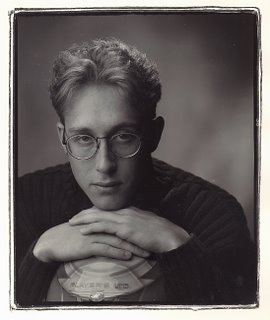
Wednesday I went to the Cirque du Soleil with Rebecca. We parked far and walked. It was a warm evening so it was a pleasant stroll through a neigbourhood that thanks to Concord Pacific is transforming the area. I played the game of telling Rebecca that we would leave at the intermission because I was bored. She didn't buy it. We both had a good time and walking back we passed ex mayor Philip Owen on Pacific Boulevard. Across the street I spotted what at one time was the headquarters of the Vancouver Indy. I remembered taking portraits there of a gracious and handsome young man, Greg Moore who posed for me in his brand new Mercedes SLK 230. That was in June 1998. Moore died the next year. I looked at the empty parking lot where Moore's car had been parked and I held tight to Rebecca's hand and walked on.
Elizabeth Aird & Her Fishnets
Thursday, June 29, 2006
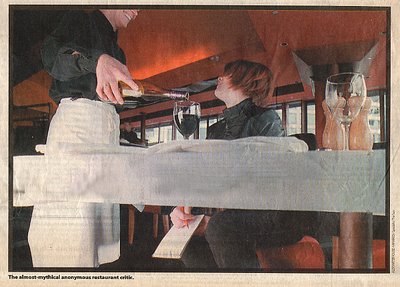
Today I read John Mackie's obituary. Sun reporter and columnist Elizabeth Aird is dead at 50. Of her, editor-in-chief Patricia Graham says,"Elizabeth was quick-witted and clever. Often frustrating but always endearing, she was a marvellous writer who had a sweet nature but wrote with the stong voice of a truly independent thinker."
I don't know of anybody who would find fault with that. I would only add that Elizabeth was the sexiest reporter that ever worked for the Vancouver Sun. Not only that, she had the finest legs, too! One of reporter John Armstrong's first pieces for the Sun, in the middle 90s, was one on the vintage furniture store on West Pender (now gone) Metropolitan Home. To illustrate the article Armstrong convinced Aird to pose in fishnets on a swank lounge chair. That photograph refreshed my libido for weeks.
It was at the end of March 2000 that I received a phone call from Jim Sutherland, then editor of the Vancouver Sun's Saturday magazine, Mix. He had written an essay in defence of Vancouver Magazine's annual restaurant awards. He wanted me to take a picture to illustrate the concept of an anonymus restaurant critic. I thought I heard wrong when he told me that Elizabeth Aird had volunteered for the shot. I asked him to repeat that. When I showed up at the Sun newsroom Aird looked at me and told me, "I only found out about this this morning. There is no time to buy fishnets." I could only stare at her black stockings and pumps as we went downstairs to Aqua Riva.
Sometimes my filing system works and sometimes not. I found Elizabeth's picture and article under Restaurant Critic but there were no slides or negs in the folder. But this will do even though I recall that the racier ones were vetted by the Sun photo editor. If anything (if you notice she is writing in a notepad under the table) this picture to me conveys Aird's joy for life.
The Editor-In-Chief & The Articulated Bus
Wednesday, June 28, 2006
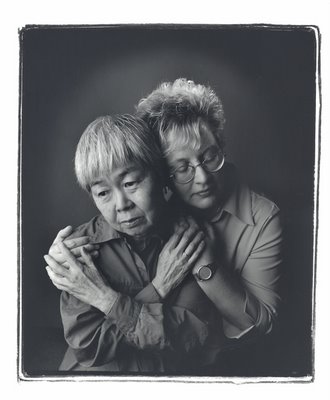
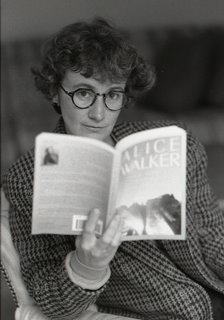
A couple of thrilling things happened to me yesterday. One of them was in a B-Line 98, articulated bus. When I got on Homer and Davie on my way home, I spotted a handsome Japanese woman with gray hair. I removed my sun glasses and stared at her. Then she remembered the connection and said, "Ramona." I had photographed her and composer director Ramona Luengen for the Straight as a preview to the young person's opera Naomi's Road based on Joy Kogawa's (the woman on the bus) experience with her family in a Canadian internment camp during WW II. The opera was comissioned by the Vancouver Opera and it was a smash hit last year. I had met Kogawa socially before so I used the opportunity to chat with her and entertain myself on my way home. I brought up the subject of being typecast (to my wife's perennial distaste I am known by many in Vancouver to only photograph the opposite sex sans clothing even though in my past I did once specialize on sewing machines) and how it affected her. She told me she was trying to do this in a current book project. I told her about writer/artist Michael Kluckner who specializes in documenting historical locations and heritage structures in British Columbia through his watercolour paintings. He also provides historical background context. His latest book Vanishing Vancouver was very well received. Rosemary and I visited Kluckner and his wife rosarian and author Christine Allen in their Langley rose farm, Killara Farm on Sunday. They have sold it (and the sheep, the ducks and the geese) and all of Christine's old roses. They are moving to Australia. Both Kagawa (when I told her) and I understand their motive. They want to start somewhere where they are unknown. Kluckner wants to paint with oil and go abstract. He believes that he could not go to a Vancouver gallery and have his oil work judged objectively. As heart wrenching as it might be to leave their beautiful farm they are young enough to enjoy the thrill of change and adventure. "I want to go to an Australian gallery and have my work rejected (or accepted)without them knowing who I am," he told me as we sipped lemonade under an oak tree. I wonder what Kogawa has in mind and what her next book will be?
And something else happened yesterday that thrilled me, too. There is nothing like going through the length of the Vancouver Sun newsroom with the Editor-in-Chief, Patricia Graham (above right), into her office. You are noticed when you leave.
Miss Willmott's Ghost
Tuesday, June 27, 2006
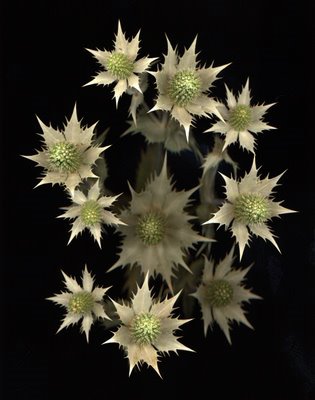
There are some skills that cannot be learned. My daughter Ale can take cuttings in our garden and all will survive. You would think that pouring water into a gourd with mate would be an easy task. Yet few can "cebar" a mate. Wealthy families in Argentina in the 19th century would have a special servant whose task it was to cebar the mates. My wife Rosemary, who can remove a delicate flan from its pan without fuss (I cannot do it), has never been able to make me a good cup of tea. Years ago when we brought our housekeeper Clemen from Mexico I pointed out to Rosemary that Clemen could make the perfect cup of tea. This was the case until I discovered that she had been re-boiling old tea! But then Clemen can make tortillas from scratch which is another one of those skills which is an either you can or cannot mystery. Marion McDonnell, the Blue Poppy Lady, grew Meconopsis betonicifolia and Meconopsis grandis. These legendary Himalayan blue poppies are impossible to grow in Vancouver (even though ourcity has the climate that can provide the constant moisture and dappled shade that this plant loves) unless you have that touch that Marion had. In fact whenever you do spy one of these blue poppies in a Vancouver garden you can bet it came from Marion's.
Ellen Ann Willmott (1858-1934) was and English lady of "independent means". She was a keen gardener and friend of Gertrude Jekyll (rhymes with treacle!). Miss Willmott had a way with plants and many of them have the Willmott epithete atached such as Rosa willmottiana. But my favourite is Eryngium giganteum 'Miss Willmott's Ghost. Legend has it that Miss Willmott in her frequent garden visits would surreptitiously sow sees from this handsome biennial (it shares this frustrating quality with the blue poppy). Garden owners would then be startled by the greyish ghost apparitions of the plant a couple of years later as the plant will not flower on the first year.
Both Rosemary and I simply do not have the touch for the plant and our specimens are puny when and if they do flower. Perhaps I will ask Ale to give it a try.
None Nicer
Monday, June 26, 2006
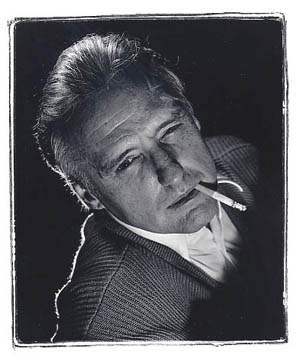


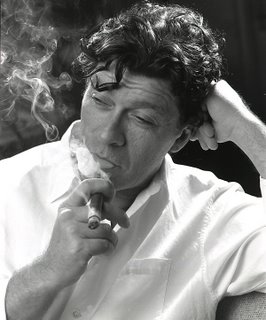
Through the years I have had the opportunity to photograph people smoking and I never gave it a thought. At the time is was seen as glamorous or part of intellectual brilliance. The first two cigarettes I ever smoked in high school exploded in my face and my classmates thought it was very funny. By the time I was 20I was smoking pipes and trying every aromatic blend I could find including Middleton's Cherry Blend (ugh!) and Sugar Barrel. By the time I was 25 I was more discerning and I had settled for Edgeworth which came in nice blue tins. If I had kept the tins I would be quite rich now. Before I stopped the habit some 16 years ago I was smoking stuff like Balkan Sobranie. Journalist Les Wiseman said it smelled like Doberman droppings. But my favourite tobacco came in tight little round slices. It was Bell's Three Nuns. I had been attracted to it ads, "Three Nuns Pipe Tobacco, None Nicer."
From top to bottom: Dennis Hopper ( smoking a Kool), Leslie Phillips (smoking an H. Upmann), Robbie Robertson ( smoking an H. Upmann) and Clive Barker (smoking a Cohiba). Had it been me I would have been smoking a Montercristo Claro which was my brand of choice when I smoked cigars in my youth.
Smokestacks & Progress
Sunday, June 25, 2006
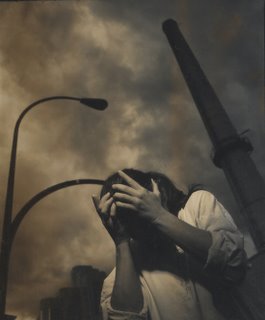
The image of progress fades and changes. As a boy when my British made electric train took me to the Buenos Aires suburb of El Tigre I would always watch for the tall smokestack that was attached to the Nestle plant that hugged the tracks. It was very tall and made of brick.The best part was that I could smell burning chocolate. In the 19th century a English cityscape full of smokestacks and smoke loudly proclaimed the age of coal.
Some 17 years ago the Georgia Straight ran an article on cuts at the Vancouver General Hospital. Things have gotten a bit more complicated since then. Try to figure out the current name of this hospital facility. It will be as difficult as trying to tell the difference between Trans Link and Coast Mountain Bus Company. The days of VGH and BC Transit are gone. That's called progress. Gone, too is the impressive smokestack of my picture. I remember that my subject was a mentally unstable patient who volunteered for the cause of showing what hospital cuts did to health care. I remember, too, that a hospital guard tried to throw us out even though we took the picture on the city sidewalk.
Bruckner & Friendship
Saturday, June 24, 2006
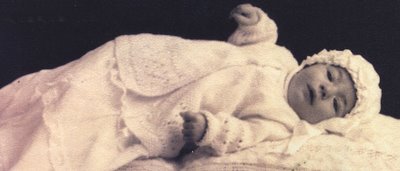
Today we are going to celebrate Graham Walker's 50th birthday even though it is next week. We are going to meet at a downtown restaurant. He is going to be lured by his wife Cathy to a dinner for two.
Recently Graham Walker (above as a baby, is a Scottish born graphic designer who has a fondness for polished shoes) sent me an email: "I have recently bought my first Bruckner recording, Symphony no. 9 unfinished. It has some interesting rehearsal tracks with the conductor talking about the work and it's reconsctructed fourth movement. I was wondering if we should have a listen to it together in honour of Juan Castelao. I know he is a big Bruckner fan."
Graham and I attend many concerts together, but principally of the baroque variety. Our friendship with Pamplona born conductor of the Vancouver Philharmonic Orchestra has widened our horizons a bit! Alas, Juan is back to working on his thesis in Oviedo. But that did not prevent Juan from expressing his opinion and suggesting (and I translate from his Spanish): "I am very sorry that I will not be there to listen to Bruckner's 9th which is one of my favourite symphonies in spite of the sadness of the 3d movement. As a matter of fact you should know that Bruckner left written instruction that his Te Deum should be played as the 4th movement of this symphony. So tell him to buy it."
I know what I wil have to buy for Graham as a birthday present. And soon Graham and I will sit in my living room. In memory of Juan we shall listen to Bruckner. Some of us are awfully lucky.
Alain Blanchard & Company
Friday, June 23, 2006
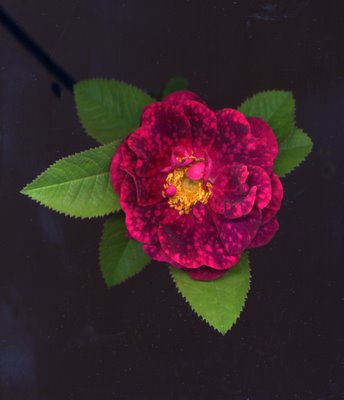
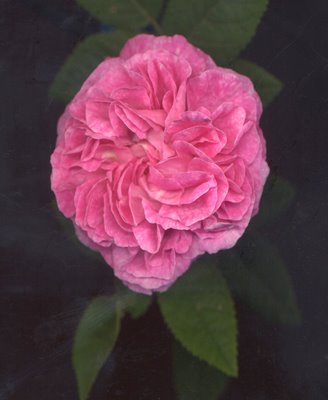
Roses are like cats and babies, they don't perform on demand. I had the intention of posting two of my "spotted" Gallica roses. I attempted to scan Rosa 'Alain Blanchard' and Rosa 'Soleil Brilliant' together last night but Alain Blanchard (above, left) decided to close his petals and did not cooperate. So I left Alain Blanchard (Vibert, 1839) for this morning. Even that was difficult as Alain's colour did not scan as I saw the rose and I had to monkey with the colour balance. The lighter shocking pink spots are almost fluorescent. So here you see both roses alone, even though they grow very close to each other in the garden. Soleil Brilliant's spots are less noticeable and perhaps the reason is that it is a young bush in its first season in my garden. Langley rose grower Christine Allen handed Soleil Brilliant to me in this year's VanDusen plant sale. "Alex,you like odd roses. This is an odd rose." I found Alain Blanchard (not the kind of rose you can normally find in nurseries) at the Burnaby Garden Works. Many people believe that my spotted roses are like that because of Vancouver rain but that is not true. I find them fascinating and even more so when Rebecca pronounces their names in her perfect French. Because they are Gallicas they have an intense perfume but only bloom once. More than any other plant in my garden these Gallicas (even the unspoted ones) give you a reason to want to stay alive through the winter to see what they will do next spring.
Sports Photography & Michael Varga
Thursday, June 22, 2006
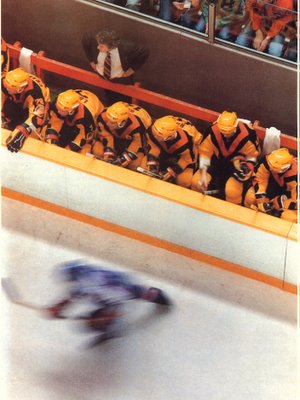
Sports photography has never been one of my strong suits. Luckily I was never asked by any magazine to shoot indoor basketball. I believe it must be extremely difficult. Magazines have assigned me in the past to shoot female rugby games, golf and hockey many times. It was the great American sports photographer Neil Leifer who best explained the problem. He pointed out that he had access to any kind of equipment including some special Canon cameras with motor drives that shot at 15 frames per second. Leifer said, "I noticed that the best picture was always between frames." Leifer understood that you have to be familiar with the game, its peak action and know instinctively the shutter lag of your camera. This is the period of time between the pressing of the shutter button and the exposing of film or sensor. The photo I include here came about because of advice from my friend Michael Varga who has been a sports cameraman for the CBC for at least 34 years. He is the best there is. When I ran into him at a hockey game at the Canuck's Coliseum (this one taken in 1983 has Roger Neilson at top left)I asked him where photographers never went. He looked up into the rafters.
Roses & the Citroën Deux Chevaux
Wednesday, June 21, 2006

On the second day of our open garden, this Sunday we were visited by Peter Lekkas and his shiny red Citröen Deux Chevaux. I quickly forgot showing Peter (a card carrying member of the Vancouver Rose Society) my red Gallicas and demanded that he take Rebecca and me for a ride in his wonderful 1978 Citroën. This was the first time I had ever been in one. In the early 60s in Buenos Aires, I often ate with my friends at the German restaurant, the Bodensee in Belgrano where besides eating multiple servings of apple pancakes we often drank too much. On our slow meandering walk home we would pick up every Fiat 600 and Citroën 2CV in sight and place it on the sidewalk behind a city tree. With Rebecca in the back seat, being inside the Citroën was much more fun than lifting one.
Part of the pleasure of riding with Belgian Peter Lekkas is that he has an infectuous positive attitude towards life that is always reflected in his easy smile. He proudly told me that his 6 Club 2CV with a 602 CC, 28 horsepower engine goes 50 miles to the gallon. The 6 Club is a luxury version since it comes with a radio.
Until recently I had never connected the man who wears a pith helmet at the VanDusen plant sale ( in the booth with the Red Patio Wonders and other mini roses) with the compassionate veterinarian at the SPCA. A pity that he is treating cats and dogs. We would be less depressed and much better persons if he treated us.
Mary Rose & Taxus baccata
Tuesday, June 20, 2006
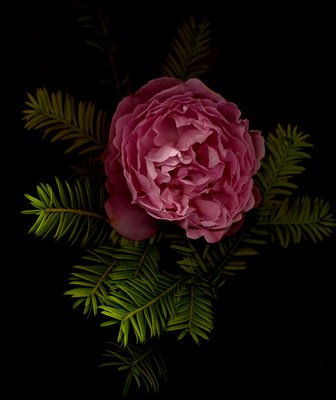
This English Rose, Rosa 'Mary Rose'and Taxus baccata are not too far from each other in my garden. Rebecca knows the story and would explain why I have scanned them together. David Austin, the Shropshire rosarian, introduced this myrrh scented rose in 1983. It is named after the 78 gun carrack which was built in Portsmouth in 1509-1510 and served in King Henry VIII's navy. She sank in the Solent Channel in a calm sea on July 18, 1545 on the second day of the Battle of the Solent. Speculation on its sinking suggests that undisciplined crew had neglected to close the lower gunports and after firing at the French galleys that she had engaged, she heeled in the evening breeze, filled with water and turned over. Recovery efforts have been underway since. In 1982 the wreck was lifted from the water and put upright in a dry dock. Many treasures were found including boxes full of longbows. These longbows which were in excellent state of preservation were carefully dried and strung. In tests, each bow took about a 100 pound pull in order to bend it so the string reached a man's eye. How could have 14th century Englishmen and Welshmen fired these bows? It is at this point that I tell Rebecca that the English fought and won two great battles, Crecy (1346) and Agincourt (1415) during the 100 Year's War in which Welsh bowmen wielded longbows made of English Yew (Taxus baccata). The might of the bows pierced the armour of the French knights and it doomed the age of chivalry. The English longbow was a precursor of other unique weapons that changed history. The Colt Peacemaker made men equal in the US West. And then came the machine gun...
Beauty and Lisa
Monday, June 19, 2006

My first ever one person show about 12 years ago came about when a show fell through at the Exposure Gallery on Beatty Street in Vancouver. The curator, Brian Lynch, called me up is desperation and asked me if I could put a show together in a week and a half. I contacted model Lisa Montonen and asked her to show up at my studio. Ken Knechtel, of Rainforest Garden, provided me with a variety of hosta leaves. In two hours I photographed Lisa with one light and in some way holding a hosta leaf. She wore nothing and the name of the hosta would suggest the pose. Here she is holding Hosta 'Hyacinthina'. This hosta is really the mother of most variegated hostas as it tends to sport and mutate with frequency. From Hyacinthina we have such excellent hostas as Gold Standard, Captain Kirk and Strip Tease. And some poetic ones, too, like Hosta 'Robert Frost'.
I had met Lisa at a beauty competition where clearly she was the most beautiful woman there. She had not won. She had been in tears and I had explained that in beauty competitions real beauty was a disadvantage.
My Father George
Sunday, June 18, 2006
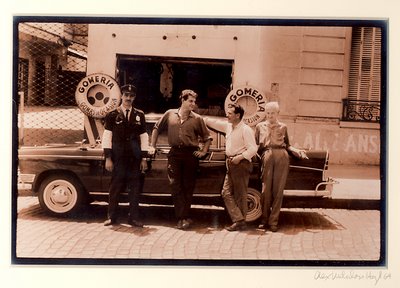
My father George taught me many things. Perhaps the most useful was how too cook since Rosemary cooked little when we married and gradually did even less. My father said, "To cook you must be able to make a sauce." That was the most practical cooking advice I ever received. I remember as a little boy being in bed with my father and both of us would sing, "Daisy, Daisy......." He read Leslie Charteris's The Saint books. He told me that Leslie was a man, in spite of his name and that the definition of such a name was epicene. This is perhaps why I called my second daughter Hilary. My father died when I was in the Argentine Navy in 1964. I took this picture on Carabobo Street in Buenos Aires two weeks before he died. These were some of his friends. The car is an Argentine built Siam Di Tella, otherwise known as an Austin A-60.
Rosemary's Garden
Saturday, June 17, 2006
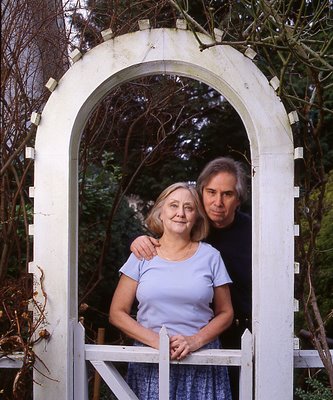
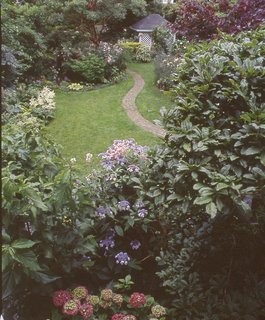
In 1986, when we moved to our present house on Athlone Street, I thought Rosemary had finally made a mistake. Rosemary never makes mistakes. Thanks to her perceptive talents and pioneering spirit we moved to Vancouver in our light blue WV Beetle with our two daughters in 1975. But this time I did not see how were were going to pay our $3200 a month mortgage. For about three years Rosemary gave me an allowance and she handled the money (as she always has). Within a couple of months I knew that if we not only had to pay the mortgage but also pay Harry Nomura, the neighbourhood Japanese gardener, things would not work out. Rosemary decided we would do the work on the lare garden of our corner lot. We learned quickly. Our garden has been featured in Better Homes and Gardens and this past May in Canadian Gardening . We have opened the garden for countless plant societies and this is the second time it is going to be opened (today and Sunday) for the City/VanDusen Tour. With this garden that began as Rosemary's, and through some gentle coaxing, I have learned a new activity which I have come to love. We share it. I have often said that it is strange how so many people escape the city, take a ferry, relax on an island and then battle ferry traffic to come back to the city. All Rosemary and I have to do is open the kitchen door and walk down to our garden. She's smart and I love her.
Leonard Cohen
Friday, June 16, 2006
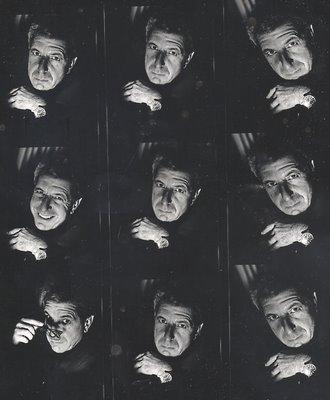
In 1968 when I was living in Arboledas, Estado de Mexico, my daugher Ale's godfather, Yorkshire man Andrew Taylor showed up at the door with an album in hand. "You're married to a Canadian. You should listen to this man." The album cover had this depressing photograph of a depressed looking man. Then we played it and two songs, Suzanne and So long, Marianne confirmed the man's depressed look. I could not believe that Andrew had spent good pesos on the record.
So it was with some unease that I faced Leonard Cohen in October, 1988. He was dressed all in black and looked scary. He told me, "I am a rotten apple at the bottom of the apple barrel who is a minority in Montreal. I am an English speaking Jew." And then he faced my camera grimly. While negative psychology has really never worked with my granddaughters Rebecca and Lauren, Cohen was receptive. I told him, "Under no circumstances are you going to laugh, or even give me a hint of a smile." And he did just that.
Argentine Nostalgia
Thursday, June 15, 2006
I am an Argentine (rhymes with whine which is something we Argentines do very well) who lived in Mexico for many years and then in Texas where I almost became an American. I arrived to Vancouver in 1975 but I didn't really feel Canadian (not when I swore allegiance to the queen with my father's King James Bible) until I participated in the Urbanarium Society's 1998 show, B+W Vancouver. My photos of architecture in Vancouver were up on the wall with the photos of Leonard Frank and Otto Landauer who recorded Vancouver from its inception. I felt that Vancouver was my city and by a logical extension that somehow I was finally Canadian. This comforting feeling of belonging did not last. Shortly after, I met transplanted Argentine artists Nora Patrich and her husband Juan Manuel Sanchez. Juan refuses to speak any English and holds to the daily tradition of drinking mate from a gourd. He reads Argentine on-line newpspapers and asks me if I have read this or that, as if the events just happened outside of his studio window facing Douglas Park. It is difficult to look at passionate and beautiful Nora without longing for the women of Buenos Aires. So I get confused and I have been since I met them. When Argentina won its first world cup game last week Nora called me to tell me, "We won." I felt it necessary to tell her, "You won. I didn't. I am Canadian." I am confused but that doesn't mean I don't thoroughly enjoy being in the company of these Argentines.
In the Company of Argentines
Painting with Argentines
Alleyne & Barbara Cook
Wednesday, June 14, 2006
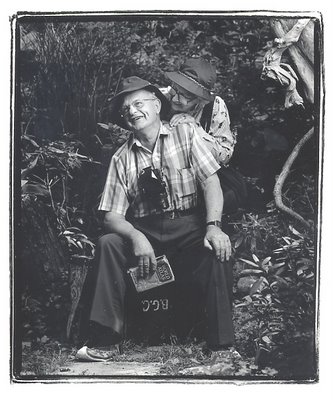
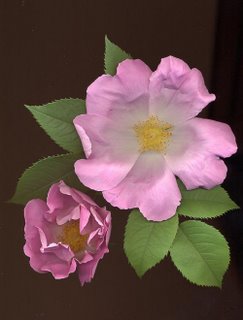
It was around noon on June 2, 1953 when my mother told me to wash my hands and knees ( I was 9, I wore short pants.) in preparation for lunch. At the risk of being spanked with a chinela (an old Spanish word for slipper) I told her that I couldn't because I was listening to the coronation of "my queen" on our living room radio. In my Buenos Aires neighbourhood of Coghlan I was known as "el inglesito" or the little English boy. On June 1, in Winkfield Village, in Berkshire, a young New Zealand gardener was busy cutting flowers. He was one of only two men, who worked at Winkfield Place, a school for well to do girls run by Constance Spry and Rosemary Hume. Constance Spry had been comissioned by Buckingham Palace to make all the floral arrangements that were to line the street from the Palace to Westminster Abbey which was to be the coronation ruite on the next day. Flowers had to be cut for the arrangements to decorate the inside of the Abbey, too. Rosemary Hume, the cooking side of Winkfield Place was brainstorming with her students to come up with a recipe to feed some of the dignitaries. The result, Coronation Chicken, will never be in the same menu with Peach Melba.
I feel privileged to have Barbara and Alleyne Cook as friends. Both are in their 80s. They live in North Vancouver and have one of the most interesting and eclectic gardens around. While Alleyne is an expert on rhododendrons (he planted many of the specimens, some very large, in Stanley Park, Queen Elizabeth Park and VanDusen because he worked for the Parks Board for many years) he knows more about magnolias than anybody else I know. And when Alleyne is quiet (this is a rare occasion) Barbara is no slouch herself on plant knowledge. Both, of course, speak with impeccable botanical nomenclature. speak with that Christchurch, New Zealand accent so that "yes" manages to have two syllables. They would still be traveling to places they love to explore exotic flora, like Russia, Iran or Africa except that they find it difficult to pay the obligatory travel/health insurance that runs in the thousands for both of them.
When I am stumped with a botanical question I call the Cooks. They always have an intelligent answer even if my question is stupid.
Barbara is crazy about modern dance and ballet. When there are performances at the Vancouver Dance Centre, Alleyne drives her to the Sea Bus. She takes the bus to Granville and Davie. Rebecca, she and I enjoy the dance. Before I drive her to the Sea Bus whe have coffee at the nearby Blenz and discuss the performance.
One of the most glorious roses in my garden is a huge unknown rose called Rosa 'Complicata' which is sometimes classified as a Gallica. A few years ago Alleyne showed up at my door with a little pot with a small rose. He placed it at my feet and said, "If you are going to have one rose, Complicata (top right) is the one. Here it is."
Perhaps I should ask him if Constance Spry had Complicata in her garden and if he cut any for those arrangements for Queen Elizabeth II, my queen.
Norman 200B - All American
Tuesday, June 13, 2006
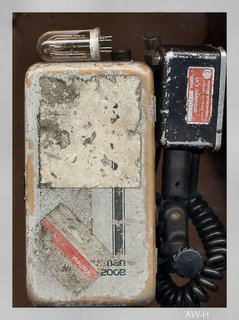

Going home to Coghlan via the cavernous English style train station of Retiro in Buenos Aires in the early 50s I often noticed a sign advertising the benefits of using Portland cement. I remember that it read Cemento Portland (USA). This meant that the product was that much better. It was the geniuine American article. We Argentines are mostly anti-American, but don't take our Levis away from us! In a city where you can buy a steak and a bottle of wine for under $10, throngs flock into McDonalds and Burger Kings. Since this former Argentine, now a Canadian citizen, was educated in Texas I have had a particular fondness for people and stuff from South of the 49th Parallel. I get into bitter fights with my Argentine painter friend Juan Manuel Sanchez who one moment says Bush is an idiot and the next blames him for all kinds of brilliant plotting with the CIA. I argue that Argentines should begin by blaming themselves for their problems. At least Argentines, unlike Mexicans cannot complain, "So far from God and so close to the United States."
While I don't have any fondness for Bush, Hummers and Yukon SUVs I must confess I love Americans and the United States. All my life I have used Kodak film because it is American. Besides I have been partial for Kodak's yellow boxes and find Fuji's green boxes ugly. Ralph Nader be damned, happiness would be a Corvair Monza in mint condition parked in my garage.
When people ask me for some of the secrets of my success as a photographer I often cite my Norman 200B. In its day (30 years ago is when I bought my first of three) the Norman 200B was the most powerful battery operated flash. At the Smithsonian I saw a Norman 200B pack damaged beyond repair by a Viet Cong bullet that penetrated its electronics, but stopped just there to save the life of some lucky American photojournalist.
I have never been let down by my Norman, and in situations when my studio flash units have failed (or even exploded) the Norman has been there to save the day. The Normans ( my vintage ones) were manufactured by Norman Enterprises in Burbank California.
On a recent trip to Kelowna for a Reader's Digest assignment I was called back from boarding my plane back to Vancouver. I was escorted by two burly men into a room. My Norman 200B case was on a table. A very serious third man asked me, "What's that?" I proceded to proudly explain what it was by connecting (all three men jumped back) the flash head to the power pack to demonstrate just what my Norman 200B could do. The big powerful burst of light warmed my heart and I saw, perhaps, signs of relief in the faces of the three men.
Above right you can see what a Norman 200B can do. It's Rebecca Stewart with Rosa 'Mrs Oakley Fisher'.
Mexico - Méjico
Monday, June 12, 2006

When the Spaniards arrived in Mexico they built churches on top of pyramids and adapted Mayan and Aztec gods to Catholicism. But it was the language of the aboriginal population that perplexed the Spaniards. One problem was a sound that manifested iteself in many different ways. But the Spaniards standardized it all with the letter j. The country became Méjico and Mexicans were Mejicanos. After Mexican independence Mexicans reverted to the letter x which had different sounds: Mexican words that beging with x are pronounced as sh so Xola is shola. An x in the middle of a word can be an s as in Taxco but j (or h) as in Oaxaca. The county of Bejar in Texas (during the Spanish period) became Bexar during the Mexican period. When Texas became Texas Bexar county became Bear County. Under Spain the inhabitants had been Tejas Indians. These were then Texas Indians and finally the state became Texas.
In 1953 my mother went to Mexico from Buenos Aires to see if our family should move there. When she came back she wrote the word as Mexico so I insisted in pronouncing it like an x. To this day Spaniards insist in writing the name of the country with a j as Méjico. To me that x made Mexico that much more exotic. When we finally arrived in Mexico in 1955 I fell in love with Mexico and I have felt a pull that has never diminished even in my contentment in Vancouver.
Sunday, June 11, 2006
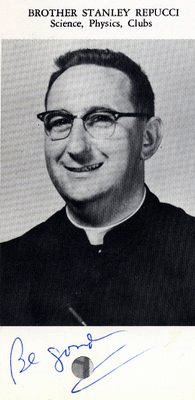
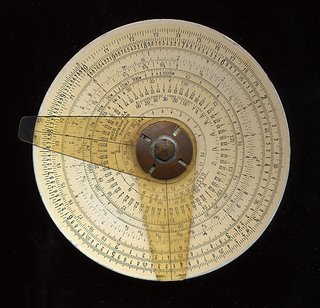
There have been few days in my life that in some way I have not thought of this big and loud man of whom I was a bit afraid of at times. To begin with I have been addicted to pizza because Brother Stanley would walk the corridors of St Edward's High School (a boarding school in Austin, Texas) on weekend evenings looking for volunteers who might want to go for a pizza. He taught me biology. In a test that would not pass muster in our frog-friendly times he told us one day, "You are each going to open up a frog and sew it back together. If your frog dies last, you will win this box of Anthony & Cleopatra cigars. Considering that few of us smoked or would have been allowed to smoke cigars on campus, we were excited. I won the box and I have no memory of what I did with it. Brother Stanly insisted that all of us buy and use a newfangled circular slide rule. It was a breeze to use and I have kept mine all these years.
But it was in grade 12 physics that Brother Stanley marked me for life. I found his class too difficult and I was afraid that by taking it my very high average (96.8 %) might suffer. I told him I was going to quit his class. His little talk (after he allowed me to quit and which I did) was, "Alex it is difficult to quit but as you quit more often you will gain experience and you will find that it becomes easier as you go. Soon you will be an expert quitter."
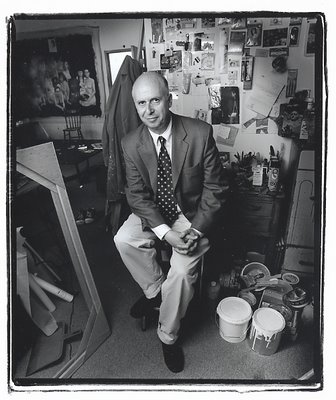
Not too long ago I went into Neil Wedman's studio and watched him paint this wonderful female nude. I returned a few days later to find that he had painted bridal clothes on her. "This is the way I always do it. This is for a show called Brides." It is a singular pleasure that my photographic studio is in the same building and on the same floor as Neil Wedman. He is a conceptual or thematic painter who can really paint. He has the technique behind his ideas. Currently he is planning a show on flying saucers. I have known Wedman for at least 15 years and I always know when he is around. You can hear him first. He has an infectious and extraordinarily loud laugh. We both share an interest in old movies. Lately we have been sharing notes on our experience with the Turner Classic Movies TV channel. Wedman told me last week, "Some days I want to go right home to watch." Wedman is an elegant but fussy dresser. His shoes are always polished.

Patrice B was one of the boys. She, Ian MacGuffie and I were inseperable friends. We had coffee at Blenz on Seymour Street together and discussed photography. Ian and I would try to convince her to stop smoking. Patrice smoked when she was stressed out over her job of taking head shots of babies and pets. We were thrilled when she was hired by the Vancouver Opera to shoot posters for one of their seasons. She was unhappy over her relationship with the lead singer of Econoline Crush. It seems that in the end she dumped him not thinking he would ever amount to much. As it was, Econoline Crush became a hit band with a hit song that was based on the singer being dumped by Patrice. A couple of weeks before Patrice moved to LA (she was going to find a way of taking photographs of Jason Priestly which she did) she asked me to photograph her. Before I even started, when she was being made up, my eyes opened and I realized she was not one of the boys.

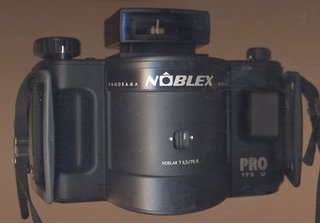
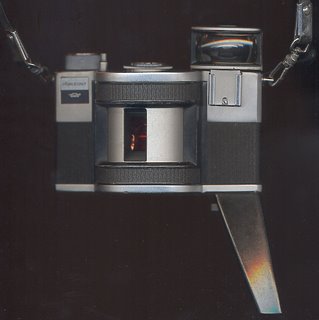
Sometime at the end of 2005 I received a call from architect Dale Rickard who is a member of an interesting and esoteric group called the Urbanarium Society. The society had a project that involved the photography of Vancouver roof gardens or gardens over the street level that were mostly semi-private. Many years ago I swore I would never use a 4x5 inch film camera and suffer seeing the world upside down. I have enough problems with the right and left of my dyslexia. I asked Rickard if he wanted photographs that had beautifully corrected perspective. I was pleased by his answer, "No we want something edgy." I accepted and edgy became dreamy as that's the overall look of most of the pictures I took with a couple of swivel lens panoramic cameras (the Russian Horizont can be seen, right) and Kodak b+w infrared film. Halfway through the project involving 13 gardens, I obtained a Noblex 175 which is a 120 film format swivel lens panoramic camera that shoots a slide that is 50mm by 175mm. The Urbanarium society, made up of landscape architects, architects and city planners, who love this city provided me with wonderful feedback and worked very hard for the show Secret Gardens which opens tonight at the Pendulum Gallery. Those of you who may read this are invited.
The Pendulum Gallery

In 1967 Alex Summers was turning the crank of a mimeograph machine inside the little office of the American Penstemon Society. He had been lured by some friends for the job. It ocurred to him that he did not like penstemons nor was he interested in publishing a journal on them. So he founded the American Hosta Society in the next year. He has not looked back. The AHS is one of the healthiest of the American plant organizations and their journal, The Hosta Journal, is a glossy publication, thick and full of useful information and illustrated with full colour photographs of hostas at their peak. The once a year national conventions are attended by hosta enthusiasts from all over the world. In the 1992 convention in Columbus, Ohio I met Alex for the first time. It took me a while to figure out that his trademark mumble camouflaged intelligence, erudition and garden knowledge second to none. He took me under his wing and gave me advice that I have never forgotten and always apply. He said:
"A garden must have three important elements. They are elevation, shade and water. And you must make sure you can hear it."
"It takes a year to plan and design a garden. You need a year to build it. You wait three years for it to mature. On the 6th year you enjoy it. In the seventh it declines. You start from scratch on the 8th." I photographed Alex in his farm in Bridgeville, Delaware. At the time his charming wife, Gene was alive. Alex here poses with a leaf of Hosta 'Aurora Borealis'. He insisted that Hosta 'Frances Williams' was this one and no other.
American Hosta Society
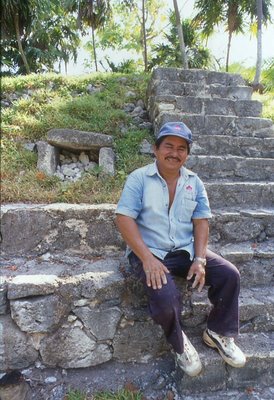
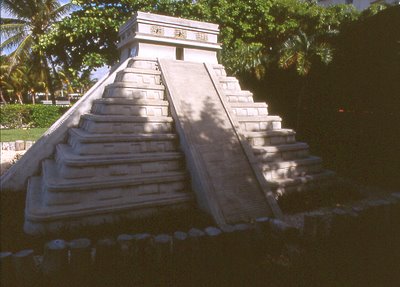
I was astounded to hear on CBC Radio yesterday that a project is underway to save Venice. It seems that the only way to save the sinking city is for a private company to buy it and convert it into a theme park. I would guess that with Las Vegas under their belt, Americans would be first in line to buy the city. I wonder if Mexico could do a better job. On a recent trip to Can Cun I was exploring the grounds of the boutique hotel Villas Tecul when I ran smack into the ruins of a pyramid. How could a hotel contain such ruins? I asked the hotel manager, Marissa Setien who promptly introduced me to the pyramid's creator here seen siting proudly. Luckily I was not driving (I was in a taxi, if not I might have smashed my car) when I saw the smaller scale replica of a Mayan pyramid (with Toltec influence). It was so perfect in the mottled lighting I could have been in the jungles of Yucatán.
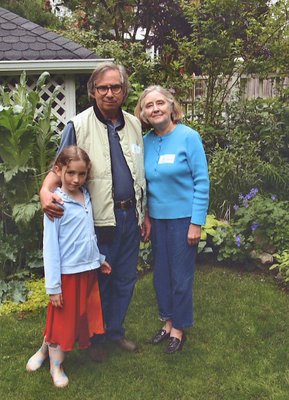
Yesterday we went to watch Rebecca dance at the end of term recital of the Arts Umbrella. Here you see her in her outfit which she had to use for the morning rehearsal. She is wearing boots because it rained for our once-a-year neighbourhood open garden. Many years ago I swore I would never ever wear that American invention, the name tag. The fact is that Rosemary and I started wearing them at hosta conventions. But I feel uncomfortable wearing them. I swear I will never wear white (or any other colour) sports shoes or go on a boat cruise to the Panama Canal. I once swore I would never ever wear a photographer's vest. Three years ago, my oldest daughter, Ale gave me the vest I am wearing here. Ale likes to go to the Salvation Army shops. I was indignant and I quickly stashed it in the darkest corner of my closet. One day I was tempted to wear it and I have love it since.
I This picture was taken by a young Mr. Lee who lives in the neighbourhood and had to photograph all the garden hosts.
Marilyn? Hosta 'Marilyn' is a gold (yellow) hosta and you can see part of it on the right of Rosemary's left hand.


Back in the late 70s Rosemary and I alternated driving our daughters Ale and Hilary to the Vancouver School of Music for ballet lessons. We did this from Brentwood in Burnaby. We would pick them up at their French schools in Coquitlam and then we would drive the stretch. During that time I took Ale and Hilary to every performance of every international ballet company that came to town. The only one I remember was the Alvin Ailey performance of Revelations where the dancers wore long white dresses, white parasols and the men white suits. Everything else is a blur. And I know why. Our daughters took ballet because that was the "correct" thing. I took them to the dance performances because I felt the obligation.
All this has changed with my granddaughter Rebecca and, I hope, with her sister Lauren. I take Rebecca to dance performances because I enjoy dance and I want to see it in the company of someone who also emjoys it. It hasn't been all easy as taking Rebecca to EDAM to watch contact improv dance can be difficult to stomach. But she has managed. Tonight we all go to watch Rebecca dance in the end of term program of the Arts Umbrella. I am looking forward to it and I am not going with the expectations that Rebecca might someday become a ballerina. That is not important. I find that ballet gives an individual grace. A prime example is Bif Naked. In one of the poses in my studio I asked her to place her hand on her head. I commented, "You're tough but you must have taken ballet some time." Her answer was, "Six months, does it show?"

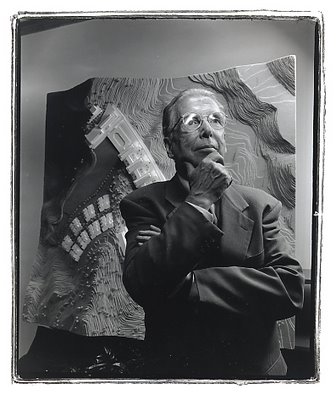

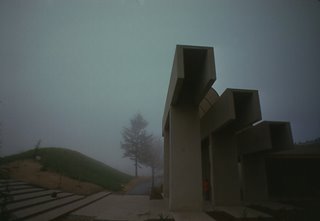
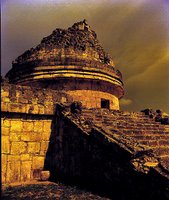
Since my photo file is in alphabetical order Vancouver Alderman Harry Rankin is right next to Scottish crime writer Ian Rankin. But I have odder bedfellows that happen to be together by accident. Today I wanted to write about the pull that Mexico has with me. Rosemary, Rebecca and I are going to Morelia in August. Last year we went to Guanajuato. So I was fishing through my 1977 files and found a bonanza of photos of my trip to the Mayan ruins in Yucatán, Chiapas, Veracruz and Oaxaca. There in the files with El Caracol ( the Mayan "observatory" in Chichen Itzá) I found a Kodachrome I must have taken at about the same time of Arthur Erickson's Museum of Anthropology. The Kodachrome is in much better shape than the medium format colour negative of El Caracol. With the Arthur Erickson restrospective show at the Vancouver Art Gallery I decided that I might as well make today's posting my own mini retrospective. The portrait of Arthur (I know him well enough and I have photographed him so many times that I can call him that) in his leather jacket I took at the museum of Anthropology in 1984. I was at the museum and hour earlier and I took Polaroids of about 5 locations. He picked this one because of the angle. Here the architect does not compete with any artifacts (Bill Read's Raven) and all you see is his building. The second photo I took in 1994.
There is a Rebecca story here. We were invited to a garden party at Arthur's three years ago. While we were there Rebecca sat in a chair in Arthur's living room. It was pointed out to me that it was Arthur's favourite chair. When I introduced Arthur as Arthur to Rebecca, Rebecca said, "That cannot be. He has no hair." I knew that Rebecca thought I meant King Arthur (the only other Arthur that I know that is just plane Arthur). Arthur (Erickson) looked at me and asked, "What did she say?" Fortunately Arthur is little bit hard of hearing.
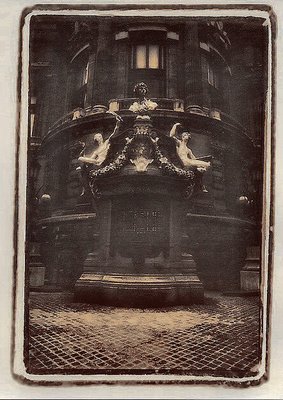
While wearing a pair of immaculate white cotton gloves, I inspected Spies for Dinner (1984), the juvenile thriller by J. Robert Janes. The Vancouver Public Library’s special collection of rare and notable books is housed, behind glass doors, on the top floor of the Robson Street main branch. Here you will not find Geology and the New Global Tectonics (1976), The Great Canadian Outback (1978) or Airphoto Interpretation and the Canadian Landscape (1984). These and a few other books by J. Robert Janes are in the lesser stacks downstairs. Nobody knows why Spies for Dinner is part of the Canadiana section of the Special Collection. I am told that it is the only copy in the Vancouver Public Library system. But then, I have come to understand that not much is known about J. Robert Janes.
I thank Baroness James of Holland Park (i.e. P.D. James) for my accidental discovery of the Niagara-on-the-Lake author. It was in 1994 that I found Carousel between two copies of James’s The Children of Men at a local bookstore. Carousel is a police procedural involving the challenged pairing of Chief Inspector Jean Louis St-Cyr of the Sureté Nationale and Gestapo Oberdetektiv Hermann Kohler. It is the occupied Paris of 1942 and as Janes points out in the introduction, even in times of war someone has to solve the everyday crimes of arson and murder. When the German army rolls into Paris, St-Cyr has to give up his black Citroen and his 1873 model, French Army Lebel revolver to Kohler. Both walk the tightrope of trying to please their respective bosses while maintaining their individual integrity. Somehow St-Cyr must hide his sympathy for the Resistance while Kohler hides his disdain for Hitler.
When I tell friends that my favourite Canadian author is Janes they look at me blankly, and then ask, “James who?” Yet whenever a new St-Cyr/Kohler novel is published glowing reviews appear by crime reviewers, Marilyn Stasio at the New York Times and Margaret Cannon at the Globe & Mail. Cannon understands the subtleties of the Janes series. While she praises their accurate portrayal of everyday life in France under the Occupier (Janes’s capitalization gives the word an eerie all-powerful connotation), she misses one of the astounding features of the St-Cyr/Kohler” novels. Cannon objects to, “…his penchant for setting the novels in the freezing French winter…” Cannon has not noticed that at the pace of almost a novel per year Janes places 11 of them within two months. The first in the series, Mayhem (l992) begins at 3 a.m. on St-Cyr’s 52nd birthday on December 3d, 1942 and 11 novels later Flykiller (2002), begins at 2:47 a.m. Berlin Time on February 4, 1943 and of course it’s still winter! The cases are solved within a week and in the last pages the next case begins, announced usually in the form of an urgent telegram. We can guess the title (always one word titles) Karneval of the next book. In Flykiller, St- Cyr hands over the telegram,
‘” Karneval,” Hermann. “Kolmar. Contact Kommandant Rasch. Hangings, Stalag III Elsas. Heil Hitler.’”
The more I tried to find information on Janes the more I became convinced he is a recluse. I asked Scott McIntyre (Douglas & McIntyre published the Janes take on the geological side of the Canadian landscape, The Great Canadian Outback) if he had any memory of working with Janes. I saw the word difficult form in his mouth but no sound came out. He told me he didn’t remember anything. When I tried to find a bio in the Canadian Crime Writer’s Society web site a click on Janes did nothing. 10 letters to the editor that Janes sent to the Globe & Mail beginning in 1979 were the only personal tidbits I was able to find. The subjects ranged from complaints about noise and beer cans being thrown into his garden during the summer Shaw Festival to an extremely liberal stance against the censorship of the arts. The prospect of writing about the wonderful books of a mysterious, reclusive and even cranky author became attractive.
And then I sent a complaint to the Canadian Writer’s Society because of the missing biography. I received a reply from Cheryl Freedman, the Secretary-treasurer. When I explained what I was up to she offered, “Do you want me to forward this to Bob? He may want to get in touch with you himself. course that will mean that your concept of Bob won’t be mysterious at all.
My E-mail communication with Janes has been a pleasant, eye-opening experience. He told me it should not change my concept of him being mysterious. “Carry on if you wish, and it is absolutely true. I don’t think it’s true at all." He labours with each book for a year. Their plots, in some cases, seem to be so beautifully serpentine that only after a second reading have I finally figured their resolution. Janes finds time to garden in his 100 year old garden (“Always after 5 pm.”), write letters to the Globe, and coach lacrosse. There is a possibility that Janes, like St-Cyr, may play the euphonium, be an amateur boxer and be able to discern the different ingredients of a woman’s perfume. The latter is an important ability, as the women in the St-Cyr/Kohler books are exquisite femme fatales. On whose side is St-Cyr’s White Russian girlfriend? The Germans, or worse still the Resistance? Kohler keeps his two mistresses in the same house while his German wife jilts him for a French prisoner of war.
Janes didn’t always write. Born in 1935, he was a petroleum engineer in the 50s and later on a research engineer and field geologist. In 1976 he became a full-time writer. He has 5 adult children and his wife Gracia is an environmental activist. I believe that his early juvenile novels are responsible for the strangely adult-like but paradoxically realistic behaviour of the children, many victims, in the St-Cyr/Kohler books. St-Cyr always has tender “dialogues” with the dead victims and when these are young children, somehow their brutal murder and the brutal presence of the Occupier is softened for you the reader while decidedly breaking your heart. For new Janes readers the dialogue of the novels can seem odd at times. Some Janes reviewers have even wondered if English is his first language. As a boy in Toronto Janes lived next to some Belgian refugees. Before they spoke in English they had to think in French. Kohler learned French as a young man as St-Cyr learned German. Janes goes trough the added task of thinking in those languages before his characters speak the English of the novels. For me this oddness increases my reading pleasure.
Kohler has two sons in the Wehrmacht who are fighting on the Russian Front. The reason Janes has plunked his novels into those three months in 1942, 1943 is that they follow the inevitable defeat of the German army in Stalingrad and the death of his sons. To keep himself awake from one case to the next Kohler pops what Janes whimsically calls Messerschmitt Benzedrines.
Kohler and St-Cyr develop a rapport (ever more quickly in wartime), while strained sometimes, that is so close that it is almost as if they were each other’s favourite old shoes. This relationship fits and feels true because Janes has a daily relationship with them. He wrote to me, “St-Cyr and Kohler are very close to me, my having been with them for nearly 14 years now. Every day, but Sunday, and then, that, often too.” Of his method of writing Janes explained, “I write not from above, as a god looking down on my characters (like most writers) but rather, right on the ground, in their shoes, and through their hearts and minds. I just wish St-Cyr and Kohler would quit taking me out behind the woodshed. That 2x4 of theirs hurts!” I just hope that J. Robert Janes can keep taking more pain. It makes me happy. And when I think of Paris I always think of a St-Cyr and Kohler Paris. This view of the Paris Opera that I took with b+w infrared film haunts me. Is the Gestapo around the corner?
The St-Cyr/Kohler Series
Mayhem, Carousel, Kaleidoscope, Salamander, Mannequin, Dollmaker, Stonekiller, Sandman, Gypsy, Madrigal, Beekeeper, Flykiller. If you can find a pristine first edition of Mayhem (Constable Books) it could cost you $350.
J. Robert Janes

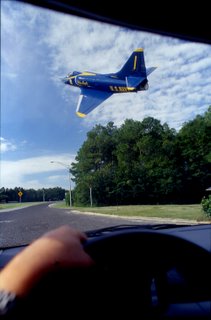

My story of the Pensacola Skyhawks really began in 1951 in Buenos Aires when Narciso Ramos, the Minister of the Philippine Legation in Argentina (the Philippines did not have an embassy yet), picked me up in his dark blue 1950 Lincoln. He was taking me to a Harlem Globetrotters game at the Luna Park. Inside the car there was a young man smartly dressed in a West Point military uniform. Narciso Ramos became Foreign Minister under Marcos many years later and the young man in the uniform was his son, Fidel who was elected president of the Philippines in 1992. Narciso Ramos had two daughters, Leticia and Gloria. Leticia Ramos-Shahani was a senator during Marcos's presidency. Gloria, who was extremely beautiful, married a dashing US Naval aviator. The aviator, Aldo Jacinto DaRodda and Gloria would vist us in Mexico in the 50s and 60s and by then he was a flight instructor at the Pensacola Naval Air Station.
In 1965 as a conscript of the Argentine Navy I was given the task of translating into Spanish the maintenance and operating manuals of the obsolescent McDonnell Douglas A-4 Skyhawks that the Armada República Argentina had just purchased from the US. I got to know these planes very well. An American Marine Corps pilot (he had the shakes as a result of fighting in the Korean war) explained everything I had to know about the planes.
During a chance viewing of a CBC TV news report during the Malvinas War I saw an Argentine Navy A-4Q Skyhawk streak very low over the horizon and suddenly there was a puff and the plane disappeared, just like that. I found that I felt no emotion for the Argentine pilot but I was devastated by the loss of what I had come to consider as one of my airplanes.
Four years ago I went to Pensacola, Florida on a travel magazine assignment. I had my heart set in going to the Pensacola Naval Air Station to visit the museum. I was thrilled to see four Blue Angel Skyhawks suspended dramatically from the museum ceiling. There was also a beautiful old Spanish fort inside the base (bottom, right).
Driving to Pensacola I took, perhaps, my most technically difficult photograph. Try to photograph a low flying Skyhawk while driving!


There have been few days in my life that in some way I have not thought of this big and loud man of whom I was a bit afraid of at times. To begin with I have been addicted to pizza because Brother Stanley would walk the corridors of St Edward's High School (a boarding school in Austin, Texas) on weekend evenings looking for volunteers who might want to go for a pizza. He taught me biology. In a test that would not pass muster in our frog-friendly times he told us one day, "You are each going to open up a frog and sew it back together. If your frog dies last, you will win this box of Anthony & Cleopatra cigars. Considering that few of us smoked or would have been allowed to smoke cigars on campus, we were excited. I won the box and I have no memory of what I did with it. Brother Stanly insisted that all of us buy and use a newfangled circular slide rule. It was a breeze to use and I have kept mine all these years.
But it was in grade 12 physics that Brother Stanley marked me for life. I found his class too difficult and I was afraid that by taking it my very high average (96.8 %) might suffer. I told him I was going to quit his class. His little talk (after he allowed me to quit and which I did) was, "Alex it is difficult to quit but as you quit more often you will gain experience and you will find that it becomes easier as you go. Soon you will be an expert quitter."
Neil Wedman - Artist
Saturday, June 10, 2006

Not too long ago I went into Neil Wedman's studio and watched him paint this wonderful female nude. I returned a few days later to find that he had painted bridal clothes on her. "This is the way I always do it. This is for a show called Brides." It is a singular pleasure that my photographic studio is in the same building and on the same floor as Neil Wedman. He is a conceptual or thematic painter who can really paint. He has the technique behind his ideas. Currently he is planning a show on flying saucers. I have known Wedman for at least 15 years and I always know when he is around. You can hear him first. He has an infectious and extraordinarily loud laugh. We both share an interest in old movies. Lately we have been sharing notes on our experience with the Turner Classic Movies TV channel. Wedman told me last week, "Some days I want to go right home to watch." Wedman is an elegant but fussy dresser. His shoes are always polished.
Patrice B - One Of The Boys
Friday, June 09, 2006

Patrice B was one of the boys. She, Ian MacGuffie and I were inseperable friends. We had coffee at Blenz on Seymour Street together and discussed photography. Ian and I would try to convince her to stop smoking. Patrice smoked when she was stressed out over her job of taking head shots of babies and pets. We were thrilled when she was hired by the Vancouver Opera to shoot posters for one of their seasons. She was unhappy over her relationship with the lead singer of Econoline Crush. It seems that in the end she dumped him not thinking he would ever amount to much. As it was, Econoline Crush became a hit band with a hit song that was based on the singer being dumped by Patrice. A couple of weeks before Patrice moved to LA (she was going to find a way of taking photographs of Jason Priestly which she did) she asked me to photograph her. Before I even started, when she was being made up, my eyes opened and I realized she was not one of the boys.
secret Gardens
Thursday, June 08, 2006



Sometime at the end of 2005 I received a call from architect Dale Rickard who is a member of an interesting and esoteric group called the Urbanarium Society. The society had a project that involved the photography of Vancouver roof gardens or gardens over the street level that were mostly semi-private. Many years ago I swore I would never use a 4x5 inch film camera and suffer seeing the world upside down. I have enough problems with the right and left of my dyslexia. I asked Rickard if he wanted photographs that had beautifully corrected perspective. I was pleased by his answer, "No we want something edgy." I accepted and edgy became dreamy as that's the overall look of most of the pictures I took with a couple of swivel lens panoramic cameras (the Russian Horizont can be seen, right) and Kodak b+w infrared film. Halfway through the project involving 13 gardens, I obtained a Noblex 175 which is a 120 film format swivel lens panoramic camera that shoots a slide that is 50mm by 175mm. The Urbanarium society, made up of landscape architects, architects and city planners, who love this city provided me with wonderful feedback and worked very hard for the show Secret Gardens which opens tonight at the Pendulum Gallery. Those of you who may read this are invited.
The Pendulum Gallery
Alex Summers
Wednesday, June 07, 2006

In 1967 Alex Summers was turning the crank of a mimeograph machine inside the little office of the American Penstemon Society. He had been lured by some friends for the job. It ocurred to him that he did not like penstemons nor was he interested in publishing a journal on them. So he founded the American Hosta Society in the next year. He has not looked back. The AHS is one of the healthiest of the American plant organizations and their journal, The Hosta Journal, is a glossy publication, thick and full of useful information and illustrated with full colour photographs of hostas at their peak. The once a year national conventions are attended by hosta enthusiasts from all over the world. In the 1992 convention in Columbus, Ohio I met Alex for the first time. It took me a while to figure out that his trademark mumble camouflaged intelligence, erudition and garden knowledge second to none. He took me under his wing and gave me advice that I have never forgotten and always apply. He said:
"A garden must have three important elements. They are elevation, shade and water. And you must make sure you can hear it."
"It takes a year to plan and design a garden. You need a year to build it. You wait three years for it to mature. On the 6th year you enjoy it. In the seventh it declines. You start from scratch on the 8th." I photographed Alex in his farm in Bridgeville, Delaware. At the time his charming wife, Gene was alive. Alex here poses with a leaf of Hosta 'Aurora Borealis'. He insisted that Hosta 'Frances Williams' was this one and no other.
American Hosta Society
Mexican Antiquities
Tuesday, June 06, 2006


I was astounded to hear on CBC Radio yesterday that a project is underway to save Venice. It seems that the only way to save the sinking city is for a private company to buy it and convert it into a theme park. I would guess that with Las Vegas under their belt, Americans would be first in line to buy the city. I wonder if Mexico could do a better job. On a recent trip to Can Cun I was exploring the grounds of the boutique hotel Villas Tecul when I ran smack into the ruins of a pyramid. How could a hotel contain such ruins? I asked the hotel manager, Marissa Setien who promptly introduced me to the pyramid's creator here seen siting proudly. Luckily I was not driving (I was in a taxi, if not I might have smashed my car) when I saw the smaller scale replica of a Mayan pyramid (with Toltec influence). It was so perfect in the mottled lighting I could have been in the jungles of Yucatán.
Rebecca, Rosemary & Marilyn
Monday, June 05, 2006

Yesterday we went to watch Rebecca dance at the end of term recital of the Arts Umbrella. Here you see her in her outfit which she had to use for the morning rehearsal. She is wearing boots because it rained for our once-a-year neighbourhood open garden. Many years ago I swore I would never ever wear that American invention, the name tag. The fact is that Rosemary and I started wearing them at hosta conventions. But I feel uncomfortable wearing them. I swear I will never wear white (or any other colour) sports shoes or go on a boat cruise to the Panama Canal. I once swore I would never ever wear a photographer's vest. Three years ago, my oldest daughter, Ale gave me the vest I am wearing here. Ale likes to go to the Salvation Army shops. I was indignant and I quickly stashed it in the darkest corner of my closet. One day I was tempted to wear it and I have love it since.
I This picture was taken by a young Mr. Lee who lives in the neighbourhood and had to photograph all the garden hosts.
Marilyn? Hosta 'Marilyn' is a gold (yellow) hosta and you can see part of it on the right of Rosemary's left hand.
Bif, Rebbeca & Grace
Sunday, June 04, 2006


Back in the late 70s Rosemary and I alternated driving our daughters Ale and Hilary to the Vancouver School of Music for ballet lessons. We did this from Brentwood in Burnaby. We would pick them up at their French schools in Coquitlam and then we would drive the stretch. During that time I took Ale and Hilary to every performance of every international ballet company that came to town. The only one I remember was the Alvin Ailey performance of Revelations where the dancers wore long white dresses, white parasols and the men white suits. Everything else is a blur. And I know why. Our daughters took ballet because that was the "correct" thing. I took them to the dance performances because I felt the obligation.
All this has changed with my granddaughter Rebecca and, I hope, with her sister Lauren. I take Rebecca to dance performances because I enjoy dance and I want to see it in the company of someone who also emjoys it. It hasn't been all easy as taking Rebecca to EDAM to watch contact improv dance can be difficult to stomach. But she has managed. Tonight we all go to watch Rebecca dance in the end of term program of the Arts Umbrella. I am looking forward to it and I am not going with the expectations that Rebecca might someday become a ballerina. That is not important. I find that ballet gives an individual grace. A prime example is Bif Naked. In one of the poses in my studio I asked her to place her hand on her head. I commented, "You're tough but you must have taken ballet some time." Her answer was, "Six months, does it show?"
Arthur & Arthur
Saturday, June 03, 2006





Since my photo file is in alphabetical order Vancouver Alderman Harry Rankin is right next to Scottish crime writer Ian Rankin. But I have odder bedfellows that happen to be together by accident. Today I wanted to write about the pull that Mexico has with me. Rosemary, Rebecca and I are going to Morelia in August. Last year we went to Guanajuato. So I was fishing through my 1977 files and found a bonanza of photos of my trip to the Mayan ruins in Yucatán, Chiapas, Veracruz and Oaxaca. There in the files with El Caracol ( the Mayan "observatory" in Chichen Itzá) I found a Kodachrome I must have taken at about the same time of Arthur Erickson's Museum of Anthropology. The Kodachrome is in much better shape than the medium format colour negative of El Caracol. With the Arthur Erickson restrospective show at the Vancouver Art Gallery I decided that I might as well make today's posting my own mini retrospective. The portrait of Arthur (I know him well enough and I have photographed him so many times that I can call him that) in his leather jacket I took at the museum of Anthropology in 1984. I was at the museum and hour earlier and I took Polaroids of about 5 locations. He picked this one because of the angle. Here the architect does not compete with any artifacts (Bill Read's Raven) and all you see is his building. The second photo I took in 1994.
There is a Rebecca story here. We were invited to a garden party at Arthur's three years ago. While we were there Rebecca sat in a chair in Arthur's living room. It was pointed out to me that it was Arthur's favourite chair. When I introduced Arthur as Arthur to Rebecca, Rebecca said, "That cannot be. He has no hair." I knew that Rebecca thought I meant King Arthur (the only other Arthur that I know that is just plane Arthur). Arthur (Erickson) looked at me and asked, "What did she say?" Fortunately Arthur is little bit hard of hearing.
J. Robert Janes & His Paris
Friday, June 02, 2006

While wearing a pair of immaculate white cotton gloves, I inspected Spies for Dinner (1984), the juvenile thriller by J. Robert Janes. The Vancouver Public Library’s special collection of rare and notable books is housed, behind glass doors, on the top floor of the Robson Street main branch. Here you will not find Geology and the New Global Tectonics (1976), The Great Canadian Outback (1978) or Airphoto Interpretation and the Canadian Landscape (1984). These and a few other books by J. Robert Janes are in the lesser stacks downstairs. Nobody knows why Spies for Dinner is part of the Canadiana section of the Special Collection. I am told that it is the only copy in the Vancouver Public Library system. But then, I have come to understand that not much is known about J. Robert Janes.
I thank Baroness James of Holland Park (i.e. P.D. James) for my accidental discovery of the Niagara-on-the-Lake author. It was in 1994 that I found Carousel between two copies of James’s The Children of Men at a local bookstore. Carousel is a police procedural involving the challenged pairing of Chief Inspector Jean Louis St-Cyr of the Sureté Nationale and Gestapo Oberdetektiv Hermann Kohler. It is the occupied Paris of 1942 and as Janes points out in the introduction, even in times of war someone has to solve the everyday crimes of arson and murder. When the German army rolls into Paris, St-Cyr has to give up his black Citroen and his 1873 model, French Army Lebel revolver to Kohler. Both walk the tightrope of trying to please their respective bosses while maintaining their individual integrity. Somehow St-Cyr must hide his sympathy for the Resistance while Kohler hides his disdain for Hitler.
When I tell friends that my favourite Canadian author is Janes they look at me blankly, and then ask, “James who?” Yet whenever a new St-Cyr/Kohler novel is published glowing reviews appear by crime reviewers, Marilyn Stasio at the New York Times and Margaret Cannon at the Globe & Mail. Cannon understands the subtleties of the Janes series. While she praises their accurate portrayal of everyday life in France under the Occupier (Janes’s capitalization gives the word an eerie all-powerful connotation), she misses one of the astounding features of the St-Cyr/Kohler” novels. Cannon objects to, “…his penchant for setting the novels in the freezing French winter…” Cannon has not noticed that at the pace of almost a novel per year Janes places 11 of them within two months. The first in the series, Mayhem (l992) begins at 3 a.m. on St-Cyr’s 52nd birthday on December 3d, 1942 and 11 novels later Flykiller (2002), begins at 2:47 a.m. Berlin Time on February 4, 1943 and of course it’s still winter! The cases are solved within a week and in the last pages the next case begins, announced usually in the form of an urgent telegram. We can guess the title (always one word titles) Karneval of the next book. In Flykiller, St- Cyr hands over the telegram,
‘” Karneval,” Hermann. “Kolmar. Contact Kommandant Rasch. Hangings, Stalag III Elsas. Heil Hitler.’”
The more I tried to find information on Janes the more I became convinced he is a recluse. I asked Scott McIntyre (Douglas & McIntyre published the Janes take on the geological side of the Canadian landscape, The Great Canadian Outback) if he had any memory of working with Janes. I saw the word difficult form in his mouth but no sound came out. He told me he didn’t remember anything. When I tried to find a bio in the Canadian Crime Writer’s Society web site a click on Janes did nothing. 10 letters to the editor that Janes sent to the Globe & Mail beginning in 1979 were the only personal tidbits I was able to find. The subjects ranged from complaints about noise and beer cans being thrown into his garden during the summer Shaw Festival to an extremely liberal stance against the censorship of the arts. The prospect of writing about the wonderful books of a mysterious, reclusive and even cranky author became attractive.
And then I sent a complaint to the Canadian Writer’s Society because of the missing biography. I received a reply from Cheryl Freedman, the Secretary-treasurer. When I explained what I was up to she offered, “Do you want me to forward this to Bob? He may want to get in touch with you himself. course that will mean that your concept of Bob won’t be mysterious at all.
My E-mail communication with Janes has been a pleasant, eye-opening experience. He told me it should not change my concept of him being mysterious. “Carry on if you wish, and it is absolutely true. I don’t think it’s true at all." He labours with each book for a year. Their plots, in some cases, seem to be so beautifully serpentine that only after a second reading have I finally figured their resolution. Janes finds time to garden in his 100 year old garden (“Always after 5 pm.”), write letters to the Globe, and coach lacrosse. There is a possibility that Janes, like St-Cyr, may play the euphonium, be an amateur boxer and be able to discern the different ingredients of a woman’s perfume. The latter is an important ability, as the women in the St-Cyr/Kohler books are exquisite femme fatales. On whose side is St-Cyr’s White Russian girlfriend? The Germans, or worse still the Resistance? Kohler keeps his two mistresses in the same house while his German wife jilts him for a French prisoner of war.
Janes didn’t always write. Born in 1935, he was a petroleum engineer in the 50s and later on a research engineer and field geologist. In 1976 he became a full-time writer. He has 5 adult children and his wife Gracia is an environmental activist. I believe that his early juvenile novels are responsible for the strangely adult-like but paradoxically realistic behaviour of the children, many victims, in the St-Cyr/Kohler books. St-Cyr always has tender “dialogues” with the dead victims and when these are young children, somehow their brutal murder and the brutal presence of the Occupier is softened for you the reader while decidedly breaking your heart. For new Janes readers the dialogue of the novels can seem odd at times. Some Janes reviewers have even wondered if English is his first language. As a boy in Toronto Janes lived next to some Belgian refugees. Before they spoke in English they had to think in French. Kohler learned French as a young man as St-Cyr learned German. Janes goes trough the added task of thinking in those languages before his characters speak the English of the novels. For me this oddness increases my reading pleasure.
Kohler has two sons in the Wehrmacht who are fighting on the Russian Front. The reason Janes has plunked his novels into those three months in 1942, 1943 is that they follow the inevitable defeat of the German army in Stalingrad and the death of his sons. To keep himself awake from one case to the next Kohler pops what Janes whimsically calls Messerschmitt Benzedrines.
Kohler and St-Cyr develop a rapport (ever more quickly in wartime), while strained sometimes, that is so close that it is almost as if they were each other’s favourite old shoes. This relationship fits and feels true because Janes has a daily relationship with them. He wrote to me, “St-Cyr and Kohler are very close to me, my having been with them for nearly 14 years now. Every day, but Sunday, and then, that, often too.” Of his method of writing Janes explained, “I write not from above, as a god looking down on my characters (like most writers) but rather, right on the ground, in their shoes, and through their hearts and minds. I just wish St-Cyr and Kohler would quit taking me out behind the woodshed. That 2x4 of theirs hurts!” I just hope that J. Robert Janes can keep taking more pain. It makes me happy. And when I think of Paris I always think of a St-Cyr and Kohler Paris. This view of the Paris Opera that I took with b+w infrared film haunts me. Is the Gestapo around the corner?
The St-Cyr/Kohler Series
Mayhem, Carousel, Kaleidoscope, Salamander, Mannequin, Dollmaker, Stonekiller, Sandman, Gypsy, Madrigal, Beekeeper, Flykiller. If you can find a pristine first edition of Mayhem (Constable Books) it could cost you $350.
J. Robert Janes
The Pensacola Skyhawks
Thursday, June 01, 2006



My story of the Pensacola Skyhawks really began in 1951 in Buenos Aires when Narciso Ramos, the Minister of the Philippine Legation in Argentina (the Philippines did not have an embassy yet), picked me up in his dark blue 1950 Lincoln. He was taking me to a Harlem Globetrotters game at the Luna Park. Inside the car there was a young man smartly dressed in a West Point military uniform. Narciso Ramos became Foreign Minister under Marcos many years later and the young man in the uniform was his son, Fidel who was elected president of the Philippines in 1992. Narciso Ramos had two daughters, Leticia and Gloria. Leticia Ramos-Shahani was a senator during Marcos's presidency. Gloria, who was extremely beautiful, married a dashing US Naval aviator. The aviator, Aldo Jacinto DaRodda and Gloria would vist us in Mexico in the 50s and 60s and by then he was a flight instructor at the Pensacola Naval Air Station.
In 1965 as a conscript of the Argentine Navy I was given the task of translating into Spanish the maintenance and operating manuals of the obsolescent McDonnell Douglas A-4 Skyhawks that the Armada República Argentina had just purchased from the US. I got to know these planes very well. An American Marine Corps pilot (he had the shakes as a result of fighting in the Korean war) explained everything I had to know about the planes.
During a chance viewing of a CBC TV news report during the Malvinas War I saw an Argentine Navy A-4Q Skyhawk streak very low over the horizon and suddenly there was a puff and the plane disappeared, just like that. I found that I felt no emotion for the Argentine pilot but I was devastated by the loss of what I had come to consider as one of my airplanes.
Four years ago I went to Pensacola, Florida on a travel magazine assignment. I had my heart set in going to the Pensacola Naval Air Station to visit the museum. I was thrilled to see four Blue Angel Skyhawks suspended dramatically from the museum ceiling. There was also a beautiful old Spanish fort inside the base (bottom, right).
Driving to Pensacola I took, perhaps, my most technically difficult photograph. Try to photograph a low flying Skyhawk while driving!






